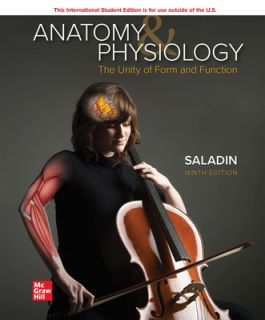Anatomy and Physiology: the Unity of Form and Function ISE
9th Edición
1260589935
·
9781260589931
© 2021 | Published: January 7, 2020
Anatomy & Physiology: The Unity of Form and Function tells a story comprised of many layers, including core science, clinical applications, the history of medicine, and evolution of the human body. Saladin combines this humanistic perspective on …
Leer Más
Gracias este es un libro electrónico o EBOOK, para poder utilizarlo debes de crear una cuenta en VitalSource Bookshelf esta es una Aplicación Gratis. Una vez que has creado tu cuenta, dentro de la plataforma debes de redimir los distintos códigos que hayas adquirido para poder leer tus libros.
Para pagos en BBVA, NO REDONDEAR el monto, por favor pague por transferencia electrónica.
- Ingresa a tu libro desde cualquier lugar o dispositivo, con acceso a internet o sin acceso.
- Crear notas, y apuntes en tus lecturas.
- Puedes realizar búsquedas a los conceptos que necesites de manera rápida y fácil.
Part One Organization of the Body
1 Major Themes of Anatomy and Physiology
ATLAS A General Orientation to Human Anatomy
2 The Chemistry of Life
3 Cellular Form and Function
4 Genes and Cellular Function
5 The Human Tissues
Part Two Support and Movement
6 The Integumentary System
7 Bone Tissue
8 The Skeletal System
9 Joints
10 The Muscular System
ATLAS B Regional and Surface Anatomy
11 Muscular Tissue
Part Three Internal Coordination and Control
12 Nervous Tissue
13 The Spinal Cord, Spinal Nerves, and Somatic Reflexes
14 The Brain and Cranial Nerves
15 The Autonomic Nervous System and Visceral Reflexes
16 Sense Organs
17 The Endocrine System
Part Four Circulation and Defense
18 The Circulatory System: Blood
19 The Circulatory System: Heart
20 The Circulatory System: Blood Vessels and Circulation
21 The Lymphatic and Immune Systems
Part Five Intake and Output
22 The Respiratory System
23 The Urinary System
24 Fluid, Electrolyte, and Acid - Base Balance
25 The Digestive System
26 Nutrition and Metabolism
Part Six Reproduction and the Life Cycle
27 The Male Reproductive System
28 The Female Reproductive System
29 Human Development and Aging
APPENDIX A: Answer Keys
APPENDIX B: Symbols, Weights, and Measures
APPENDIX C: Periodic Table of the Elements
APPENDIX D: The Genetic Code and Amino Acids
APPENDIX E: Medical Word Roots and Affixes
1 Major Themes of Anatomy and Physiology
ATLAS A General Orientation to Human Anatomy
2 The Chemistry of Life
3 Cellular Form and Function
4 Genes and Cellular Function
5 The Human Tissues
Part Two Support and Movement
6 The Integumentary System
7 Bone Tissue
8 The Skeletal System
9 Joints
10 The Muscular System
ATLAS B Regional and Surface Anatomy
11 Muscular Tissue
Part Three Internal Coordination and Control
12 Nervous Tissue
13 The Spinal Cord, Spinal Nerves, and Somatic Reflexes
14 The Brain and Cranial Nerves
15 The Autonomic Nervous System and Visceral Reflexes
16 Sense Organs
17 The Endocrine System
Part Four Circulation and Defense
18 The Circulatory System: Blood
19 The Circulatory System: Heart
20 The Circulatory System: Blood Vessels and Circulation
21 The Lymphatic and Immune Systems
Part Five Intake and Output
22 The Respiratory System
23 The Urinary System
24 Fluid, Electrolyte, and Acid - Base Balance
25 The Digestive System
26 Nutrition and Metabolism
Part Six Reproduction and the Life Cycle
27 The Male Reproductive System
28 The Female Reproductive System
29 Human Development and Aging
APPENDIX A: Answer Keys
APPENDIX B: Symbols, Weights, and Measures
APPENDIX C: Periodic Table of the Elements
APPENDIX D: The Genetic Code and Amino Acids
APPENDIX E: Medical Word Roots and Affixes
Anatomy & Physiology: The Unity of Form and Function tells a story comprised of many layers, including core science, clinical applications, the history of medicine, and evolution of the human body. Saladin combines this humanistic perspective on anatomy and physiology with vibrant photos and art to convey the beauty and excitement of the subject. To help students manage the tremendous amount of information in this introductory course, the narrative is broken into short segments, each framed by expected learning outcomes and self-testing review questions.

